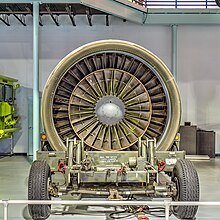|
General Electric TF39
The General Electric TF39 is a high-bypass turbofan engine that was developed to power the Lockheed C-5 Galaxy. The TF39 was the first high-power, high-bypass jet engine developed. The TF39 was further developed into the CF6 series of engines, and formed the basis of the LM2500 and LM6000 marine and industrial gas turbine. On September 7, 2017, the last active C-5A powered with TF39 engines made its final flight to Davis-Monthan Air Force Base for retirement.[1][2] The TF39 was effectively retired, and all remaining active C-5 Galaxies are Rebuilt C-5M Super Galaxies, powered by F138-GE-102 (derivative of General Electric CF6-80C2, specifically for C-5M upgrade) engines. DevelopmentThe United States Air Force opened the "CX-X Program" in 1964, intending to produce a next-generation strategic airlifter. Of the several airframe and engine proposals returned for consideration, Lockheed's aircraft and General Electric's engine were selected for the new design in 1965. The high-bypass turbofan was a huge leap in engine performance, offering a thrust of 43,000 pounds, while improving fuel efficiency by about 25%.[3] The TF39 had an 8:1 bypass ratio, a 25:1 compressor pressure ratio, and a 2,500 °F (1,370 °C) turbine temperature made possible by advanced forced-air cooling. The first engine went for testing in 1965. Between 1968 and 1971, 463 TF39-1 and -1A engines were produced and delivered to power the C-5A fleet. Design  The TF39 was a revolutionary 1960s engine rated from 41,000 to 43,000 lbf (191 to 205 kN) of thrust. It introduced use of a large by-pass ratio which, together with advances in core technology, contributed to a significant improvement in fuel efficiency over engines available at the time. The engine included features developed from previous GE engines:
The high-bypass ratio of 8:1 for the TF-39 had its origins in the lift-fan technology demonstrated by GE in the XV-5 Vertifan aircraft.[4] This aircraft had two X353-5 engines, each consisting of a 62.5-inch-diameter[6] lift-fan driven by a gas generator (J85). The bpr in VTOL operation was 12.3.[7] This tip-turbine driven lift-fan concept was turned 90 degrees and developed as an 80-inch-diameter "cruise fan" demonstrator, driven by a J79 gas generator.[4] For the CX-X program GE demonstrated a half-scale engine, the GE1/6, with 15,830 lb thrust and an sfc of 0.336.[8] This was developed into the TF39 with a 97 in diameter fan. By modern standards the Low Pressure Compressor on the TF-39 is fairly unique as a single T-stage is mounted upstream of the fan rotor, rather than behind it. Although this T-stage supercharges the inner section of the fan rotor, not all of this airstream enters the High Pressure Compressor as a fair proportion also enters the bypass duct to supplement the air discharging from the outer section of the fan. In other words there are three streams leaving the fan, two of which enter the bypass duct [9]. ApplicationsSpecifications (TF39-1C) Data from [10] General characteristics
Components
Performance
See alsoRelated development Comparable engines Related lists References
External linksWikimedia Commons has media related to General Electric TF39. |
||||||||||||||||||||
Portal di Ensiklopedia Dunia
